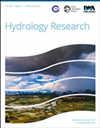支流流入量对主流非稳定流滞后和流体力学的影响
IF 2.4
4区 环境科学与生态学
Q2 Environmental Science
引用次数: 0
摘要
洪水传播是水文监测和预报的一个重要方面。以往的研究主要关注洪水传播过程中能量损失造成的等级曲线滞后。然而,支流入流对下游滞后的影响仍不清楚,导致对支流入流是加强还是削弱滞后的实地观测结果不一致。在本研究中,我们进行了水槽实验,以确定非稳定流滞后与支流排量大小和主流非稳定流周期之间的关系。结果发现,与主流非稳定流的周期性变化相比,支流的排水量变化对滞后的影响更大。有趣的是,随着支流排水量的增加,非稳定流的滞后现象先是增强,然后减弱。当支流流量较低时,下游断面的拓宽会使洪波变得尖锐,从而增加滞后性。然而,当支流排水量增加并对主流产生回水效应时,压力梯度会使洪波变平,从而减弱滞后性。这项研究加深了我们对支流入流如何影响洪水在主流中传播的理解,为洪水预测和控制提供了新的见解。本文章由计算机程序翻译,如有差异,请以英文原文为准。
Effects of tributary inflows on unsteady flow hysteresis and hydrodynamics in the mainstream
Flooding propagation is a crucial aspect of hydrological monitoring and forecasting. Previous studies have focused on hysteresis in the rating curve, caused by energy loss during flood propagation. However, the impact of tributary inflow on hysteresis downstream remains unclear, leading to inconsistent field observations on whether it strengthens or weakens hysteresis. In this study, we conducted flume experiments to identify the relationship between hysteresis in unsteady flow and the discharge magnitude of the tributary and the unsteady flow period in the mainstream. It was found that the discharge variations in the tributary had a larger influence on hysteresis compared to the periodical variations in the mainstream unsteady flow. Interestingly, the hysteresis of the unsteady flow had an initial strengthening followed by weakening as the tributary discharge increased. When the tributary inflow was low, the widening of the downstream cross-section sharpened the flood wave, increasing the hysteresis. However, as the tributary discharge increased to generate a backwater effect on the mainstream, the pressure gradient flattened flood waves, thereby weakening the hysteresis. This study improves our understanding of how tributary inflow affects flood propagation in the mainstream, offering new insights for flood prediction and control.
求助全文
通过发布文献求助,成功后即可免费获取论文全文。
去求助
来源期刊

Hydrology Research
Environmental Science-Water Science and Technology
CiteScore
5.30
自引率
7.40%
发文量
70
审稿时长
17 weeks
期刊介绍:
Hydrology Research provides international coverage on all aspects of hydrology in its widest sense, and welcomes the submission of papers from across the subject. While emphasis is placed on studies of the hydrological cycle, the Journal also covers the physics and chemistry of water. Hydrology Research is intended to be a link between basic hydrological research and the practical application of scientific results within the broad field of water management.
 求助内容:
求助内容: 应助结果提醒方式:
应助结果提醒方式:


